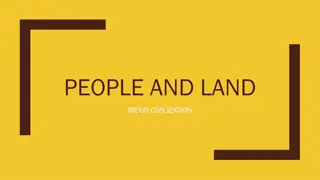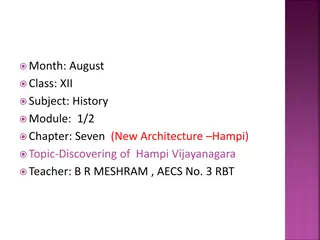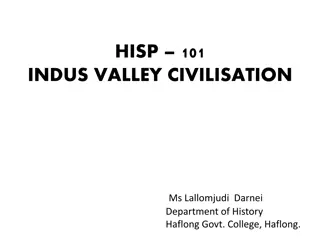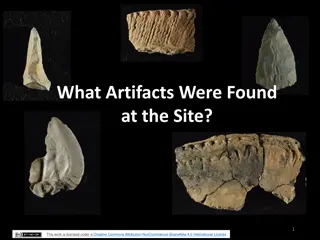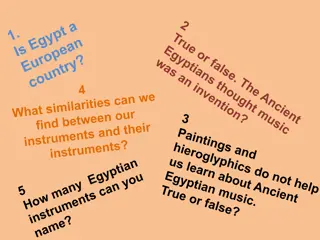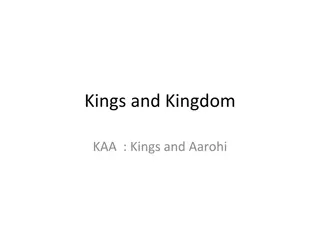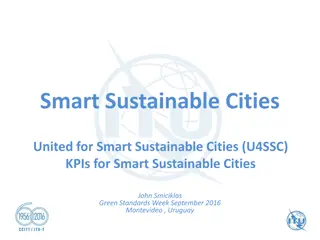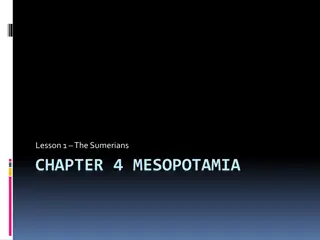Exploring the Indus Valley Civilization: Artifacts, Cities, and Origins
Delve into the ancient Indus Valley Civilization, dating back to 2500 B.C.E. Uncover the roots of this civilization, its carefully planned cities such as Harappa and Mohenjo-Daro, and the exquisite artifacts including pottery, metalwork, and small sculptures. Discover the intriguing early trade routes and the remarkable craftsmanship of this ancient society.
Download Presentation

Please find below an Image/Link to download the presentation.
The content on the website is provided AS IS for your information and personal use only. It may not be sold, licensed, or shared on other websites without obtaining consent from the author. Download presentation by click this link. If you encounter any issues during the download, it is possible that the publisher has removed the file from their server.
E N D
Presentation Transcript
Indus Valley Civilization 2500 B.C.E Prof. Tarun Kanti Kumar Associate Professor Department of History Bethuadahari College Bethuadahari, Nadia
Roots of Indus Valley Civilization Earliest civilizations in Indus Valley was discovered in 1856 by a railroad crew. Harappa Mohenjo-Dara or Hill of the Dead Both cities shared urban design and architectural features. 3 miles in circumference with populations of 40,000
Roots of Indus Valley Civilization Roots of Indus Valley began as early as 7000 B.C.E. Possibly began as herders who moved into the river valley during colder months. Over time, they may have decided to farm river- watered lands of the valley. They began trading by boat along the Indus down into the Arabian Sea, into the Persian Gulf, and up the Tigris and Euphrates into Mesopotamia.
The Artifacts: Crafts and the Arts Crafts of the Indus valley included pottery making, dyeing, metal working in bronze, and bead making. Bead materials included: jade from the Himalayas, lapis lazuli from Afghanistan, turquoise from Persia, amethyst from Mewar in India, and steatite, which was found locally.
The Artifacts: Crafts and the Arts Small sculptures in stone, terra cotta, and bronze appear to represent priestly or governmental officials, dancing girls, and perhaps mother goddesses. Since there are no surviving texts to explain identities, these can only be guesses.
The Artifacts: Crafts and the Arts Dice and small sculptures of bullock carts were probably used as toys and games. The first known use of cotton as a fiber for weaving textiles occurred in the Indus Valley.
Carefully Planned Cities Originating around 2500 B.C.E. the thriving civilizations survived for around 500 years. Both Harappa and Mohenjo-Daro, two of the largest among 500 sites, were three miles in circumference with around 40,000 people.
Mohenjo-Daro and Harappa To the north is a citadel or raised area. In Mohenjo-Daro, the citadel is built on an architectural platform about 45 feet above the plain. On the summit was a huge communal bath. Next to the large bath was a huge open space a granary where food was stored from possible floods. Fortified walls mark the southeast corner.
Mohenjo-Daro and Harappa The lower city was laid out in a gridiron with the main streets about 45 feet wide. Private houses, almost every one with its own well, bathing space, and toilet consisting of a brick seat over a drainage area. Brick-lined drains flushed by water carried liquid and solid waste to sumps, where it was carted away, probably to fertilize nearby fields.
Mohenjo-Daro and Harappa The town plan was regular. Even fire-baked bricks were uniform in size and shape. The regularity of plan and construction suggests a government with organization and bureaucratic capacity. No monumental architecture clearly marks the presence of a palace or temple. There is little sign of social stratification in the plan or buildings.
Indus Valley Burial Sites Heads pointing to the north Some grave goods, such as pots of food and water, small amounts of jewelry, simple mirrors, and some cosmetics. Not extravagant like royal burials of Egypt or even of Mesopotamia.
Indus Valley Archaeological Finds Among the 20,000 artifacts uncovered, the extraordinary extremes of wealth and poverty of Egypt and Mesopotamia do not appear. Why do you think that is the case?
Indus Valley Archaeological Finds Questions of Interpretation: Artifacts stress the apparent classlessness of the society. Until the Harappan language is deciphered, its civilization will remain mysterious.








